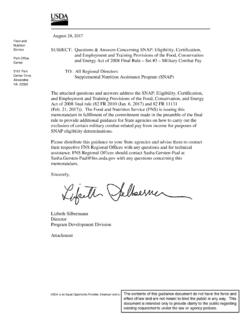Transcription of This page intentionally left blank.
1 This page intentionally left blank. SNAP E&T Operations handbook : A Step-by-Step Guide to Developing, Implementing, and Growing a SNAP E&T Program Authors: David Kaz, Seattle Jobs Initiative Maureen Sarna, Abt Associates Julie Strawn, Abt Associates Submitted By: Submitted to: Seattle Jobs Initiative Office of Employment and Training 1200 12th Avenue S, Suite 160 Supplemental Nutrition Assistance Program Seattle, WA 98144 Food and Nutrition Service 3101 Park Center Drive Alexandria, VA 22302. Project Director: Project Officer: David Kaz Marcie Foster Contributors: Rachel Gragg, Moira Johnston, Rick Krauss, Bri Nguyen, Susan O'Callaghan, Loretta Robertson, Laura Rowley, Bob Thibodeau, Kaila Wilson, and Jackie Windfeldt This handbook was created under contract number AG-3198-C-15-0024.
2 It was last revised on January 19, 2018. This resource is available on the SNAP to Skills website: In accordance with Federal law and Department of Agriculture policy, this institution is prohibited from discriminating on the basis of race, color national origin, sex, age, or disability. To file a complaint of discrimination, write USDA, Director, Office of Civil Rights; Room, 326-W, Whitten Building, 1400 Independence Avenue, SW, Washington, DC 20250-9410 or call (202) 720-5964. (voice and TDD). USDA is an equal opportunity provider and employer. 1. SECTIONS: PAGE: Introduction to the SNAP E&T Operations handbook 3. PLAN. Program Planning and Development A. Organizing a Planning Group and Process 6. B. Developing a SNAP E&T Implementation Plan 10. IMPLEMENT. Program Operations and Management C.
3 Building a System for Data Tracking, Reporting and Analysis 15. D. Securing Third-Party Partners 17. E. Building a System of Participant Referral 20. F. Building a System of Participant Eligibility Confirmation and Invoicing 23. G. Operationalizing Third-Party Partnerships 27. GROW. Program Growth and Sustainability H. Planning for Growth 30. I. Factors for Growth 33. 2. Introduction to the SNAP E&T Operations handbook The purpose of the Supplemental Nutrition Assistance Program Employment and Training (SNAP E&T). Operations handbook is to provide States and their partners a roadmap to building a SNAP E&T program that primarily uses third-party providers for the delivery of SNAP E&T services. True to its name, this resource is primarily focused on operational best practices. This means that it focuses on the nuts and bolts of how to build a SNAP E&T program that uses third-party partners to provide services.
4 It does not include information on programmatic best practices ( evidence-based strategies that help SNAP. participants gain skills and find work) or provide official policy guidance. The Department of Agriculture (USDA), Food and Nutrition Service (FNS) has published other materials on these topics that can be found on the FNS website. The handbook provides guidance that is general enough to be useful to all States while still offering a level of detail that will allow State agencies to take meaningful steps forward with their programs. States that do not utilize third-party partnerships may also find sections of this handbook useful to their work. SNAP E&T Program Basics The following section provides a brief overview of the SNAP E&T program. For a comprehensive guide to the program and Federal SNAP E&T policy, please refer to the SNAP E&T Toolkit on the FNS.
5 Website. SNAP E&T can help SNAP participants gain skills, training, or work experience to increase their ability to obtain regular employment that leads to economic self-sufficiency. The program offers funding to States to provide a package of employment and training and related supportive services to SNAP. participants, which States set forth in their annual SNAP E&T plans. States have considerable flexibility to determine which SNAP participants to serve (including whether participation will be voluntary or mandatory), which specific services (components) to offer, and who will provide the services (the State and/or partners engaged by the State). Allowable components include job Using this handbook with a State's Planning Group search, job search training, workfare, work experience or training, Section A of the SNAP E&T Operations handbook provides educational programs, self-employment information on organizing a State SNAP E&T Planning programs, and job retention.
6 Group and a planning process for developing an expanded SNAP E&T program. It lists the types of agencies and There are three types of Federal organizations that States can consider for their Planning funding for SNAP E&T: 100 percent Group, and describes how this Group can be helpful in funding, which is provided to States advancing a SNAP E&T plan. States should provide group annually through grants; 50/50 funding, members with copies of this handbook and companion which can be used to support resources early on to help them develop understand the administrative costs or participant elements of a strong SNAP E&T program. reimbursements; and Able-Bodied Adults Without Dependents (ABAWDs) pledge funding, which is dedicated to State agencies that pledge to serve all at risk ABAWDs in the last month of the 3-month time limit by placing them in a qualifying component.
7 A full discussion of Federal SNAP E&T funding, including allowable costs and relevant cost principles, can be found in the SNAP E&T Toolkit. Due to limited 100 percent funding, States have increasingly relied on the use of SNAP E&T 50/50. funding to grow their programs. This funding stream allows States and their partners to use non-Federal 3. funds to provide services and supports to SNAP E&T participants and receive a 50 percent reimbursement by USDA on those expenditures. A common way for a State to leverage SNAP E&T 50/50 funding is by partnering with third parties ( , community-based organizations and community colleges) to deliver services. This is referred to as a third-party partnership . In this model, organizations can use non-Federal funding for allowable SNAP. E&T services and supports, which are then eligible for a 50 percent reimbursement through the State's SNAP E&T program.
8 Since State funding is often limited, third-party partnerships can allow States to grow their programs, reach more SNAP participants and improve their program outcomes by tapping into existing high quality providers that serve the community. Organization of the Operations handbook The SNAP E&T Operations handbook is organized chronologically to reflect how States typically progress through the three-stage process of building a SNAP E&T program. The three stages are: PLAN. (Program Planning and Development), IMPLEMENT (Program Operations and Management), and GROW (Program Growth and Sustainability). PLAN IMPLEMENT GROW. Program Planning and Program Operations Program Growth and Development and Management Sustainability Sections A - B Sections C - G Sections H - I. In the PLAN stage, States work on program planning and development.
9 They might conduct an assessment of their existing SNAP E&T programs, create teams and processes to carry out program planning and development, and draft an implementation plan to guide their work. In the IMPLEMENT stage, States work to strengthen program operations and management. They implement their plan for developing or expanding their SNAP E&T programs. Relevant sections of the handbook cover topics such as collecting and reporting outcome data, securing and operating third-party partnerships, and building systems of participant referral, eligibility, and invoicing. 4. Finally, in the GROW stage, States work on program growth and sustainability. They expand on their initial program. Relevant sections of the handbook cover key considerations for moving from initial SNAP E&T program implementation to a larger, sustainable, effective and efficiently-run program.
10 While the handbook is organized chronologically in stages, each section stands alone. States can use only those sections that are relevant to their needs at a particular point in time and return to the document as their needs change. Some sections identify additional resources that States and their partners may find useful. These resources are part of the SNAP to Skills Project Resource Library, available on the SNAP. to Skills website. Where to Go for More Information This handbook is just one important tool for States and other stakeholders to use in planning and implementing a SNAP E&T program. The following resources provide additional guidance and technical assistance: The SNAP E&T Toolkit provides key policy guidance and information from FNS on allowable costs and best practices in SNAP E&T.











